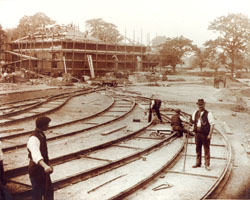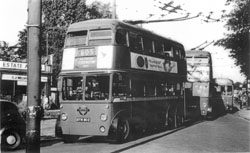Fulwell Depot
Trams, trolleybuses and omnibuses - a hub for road transport in south west London
1902 - today


Tracks, with a gauge of 4ft 8.5in, were laid along the planned routes. As it was necessary to widen the road in front of Garrick's Villa to make way for the tracks, the house was bought by the London United Tramway Company in 1902 for demolition. Fortunately for future generations, the general manager of the company, Mr (later Sir) J. Clifton Robinson, decided to live there himself. The wall on the Hampton Court side had to be set back to where it is today, but the only other alteration made by the company was the provision of a siding for Mr Clifton Robinson's private tram so that he could be driven directly to and from work. The Clifton Robinsons' tenure of Garrick's Villa was marked by great social activity. Flower shows and fetes were held there as well as enormous garden parties for company employees - two thousand being brought in relays by seventeen special tramcars stopping outside the door.
Arthur Brazier, a local railway worker, noted that "The ruination of Twickenham was when the trams came. All the big people in Twickenham that used to go out with their horses and their grooms moved (away)".

Fulwell Depot - a grand and lofty scale
The five and a half acre site off South Road was secured after lengthy negotiations with the owners, Freake Estate Trustees. The site was awkwardly shaped and is best described as a 'cranked rectangle'. A 99 year lease at £200 a year was agreed in April 1902. Building work started without delay. The freehold was eventually bought by the London Passenger Transport Board in 1937.
Apart from the structural steel work and the central heating system, all the work was carried out by company staff. The car shed was built to a decorative style. The elevations present four gabled and pedimented spans, each with space beneath for five tracks. Circular glazed openings are at the top of each gable and in one of these is a large clock. Ten foot walls with stone capped piers form the boundary. Each entrance is guarded by heavy wrought iron gates, with their piers supporting ornamental wrought iron lamp fittings.
Trams - maintenance and fitting out
The depot was one of the largest in Greater London - 18 tracks with a gauge of 4ft 8.5in. The car shed measured 400 ft by 258 ft and had frontages to and access from both Stanley Road to the east and Wellington Road to the west. Of the eighteen tracks in the car shed, fifteen accommodated 165 tram cars. The remaining three were used as a repair shop accommodating 24 tram cars undergoing maintenance work. In 1929 Fulwell received a tram car washing machine. Surplus, open-top trams were broken up in the east yard, known as the 'boneyard'. The depot also accommodated tram cars for Shepherds Bush, Hammersmith and Hampton Court Termini.
And in 1930-31 the newly built 'Feltham' type trams were fitted out and painted at the Fulwell Depot. These contrasted favourably with the antique appearance of the earlier trams. Each one was delivered in shell form from the Union Construction Finance Company's works in Feltham, on a road trailer hauled by a steam engine hired from Pickford & Co.
The trams continued to run until 27 October 1935.

Trolley buses - the first in LondonThe first trolley buses in the London area ran from Fulwell depot which became the operating base for these services. Trolley bus capacity was for 120 vehicles.
On 16 May 1931 Ronald Hadland was chosen to be the conductor of the very first trolleybus, a No.4, which opened the service between Teddington and Twickenham. He was selected for his smart turn-out. "I used to be a shining example in those days" he commented. "I spent two hours every day cleaning my uniform and had cuffs gleaming like patent leather and buttons twinkling like stars".
First he took a "show" bus into Twickenham for an official opening of the service by the mayor; then was the conductor of the leading vehicle on the six-mile round trip from Fulwell through Twickenham Junction to Teddington. As this first trolleybus moved out of the depot, District Inspector Charles Gilbert jumped aboard and paid a penny for the first ticket.
It seems Ron Hadland was also the conductor on "Diddler" No.1 when it was resurrected for a ceremonial run from Twickenham to Kingston and back on the afternoon of 8 May 1962, the last day of trolleybus operation in London.
Watch a video of the first trolleybus journey (make sure your computer's sound is switched on):
Converted in 1962 to a bus garage, Fulwell took in a complement of 60 buses - the double decker Routemasters and the standard single decker bus the RF. When Twickenham garage closed in 1970 their fleet of buses moved to and operated from Fulwell.
The southern part of the garage and the Stanley Road entrance were let out to a number of companies: in the 70s to the Grundy company, manufacturers of brewing equipment and the metal boxes that school dinners are cooked in; in the 80s to London Bus Sales for selling withdrawn London Transport buses; in the 90s to the construction company Kelly laying cable TV in the area. In March 2000 a group of travellers moved in.
The garage became all double decker in 1982 and from 1985 entirely one-person operated. In 1986/7 the garage was rebuilt but it remained open throughout. It was split across the width rather than the length. The result is a very large square garage.
The total number of buses at the garage has varied over the years:
1955: 84 trolley buses
1966: 59 buses: RM and RF
1976: 87 buses: RM, SMD, DMS and BL
1987: 82 buses: M
1994: 101 buses: M, DT and DR
2001: 107 buses: M, VA, DPS, DR, DRL and DN
Routemaster - the classic double decker (RM); RF - standard post war single decker (RF); 'The Londoner' - double decker (DMS); Metrobus - double decker (M); Dennis Dart - single decker with various bodies (DT), (DR), (DRL), (DPS); Volvo Olympian - double decker (VA); DAF - double decker (DN).
Fulwell has been the hub for road transport in the outer part of southwest London for over a century. Its vehicles and staff have formed a key part of local life and continue to provide a first class service to the bus companies operating from the depot.Further reading"London United Tramways, Vol 2", C S Smeeton, 2000.
"Twickenham and Kingston tramways", Robert J Harley, 1999.
"London Transport bus garages since 1948", J Joyce, 1988.
London Transport bus garages", John Aldridge, 2001.




